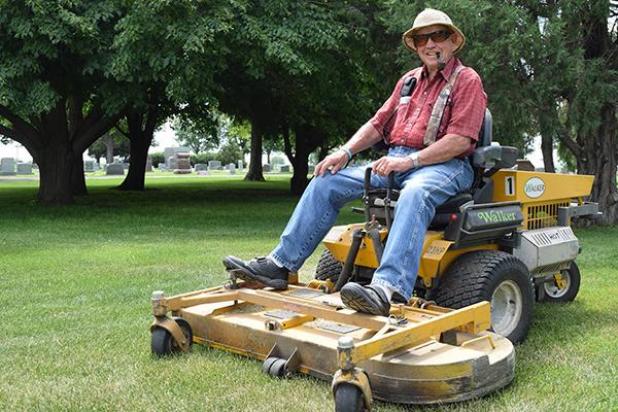
Vern “Pancake” Adams smokes his pipe while sitting atop a riding mower in Holyoke Cemetery. Adams is a member of the cemetery’s groundskeeper team, which is led by head groundskeeper Zeke Finch. — Johnson Publications
Cemetery offers residents an outlet for civic pride, window into past
Just off County Road 41, surrounded by farmland, one of Holyoke’s oldest institutions tells the story of the city’s oldest residents.
Holyoke Cemetery is a site of communion between the city’s present and past. New burials are laid out beside the plots of established families like the Heginbothams, Millages and Colglaziers.
Every day, visitors from Phillips County and beyond come to the cemetery to pay their respects to departed friends. What they all share are roots in Holyoke, by way of their loved ones.
As Holyoke Cemetery passed the 129th anniversary of its establishment this week, cemetery administrators got the chance to reflect on the history of the site and the ways in which the cemetery has served the community today.
Even before its patenting, the area of Holyoke Cemetery was used as a burial site by early settlers.
Present-day Phillips County was little more than a sea of grass when the first homesteaders arrived in 1884.
Lacking building materials, the new arrivals built sod houses against the elements, and the harsh conditions claimed many lives. The cemetery soon became one of a few nodes uniting the fledgling prairie community, along with the post office and churches.
In 1889, Phillips County acquired the Holyoke Cemetery by patent and legitimized the final resting places of some of the town’s earliest residents.
The cemetery remained under County control until 1941, when the City purchased it from Phillips County for $1 and “other valuable consideration.”
Since then, the cemetery has grown to include roughly 15 acres of greenery and more than 3,200 graves. Holyoke Cemetery Board secretary Tillie Fisbeck said between 25 and 40 people are buried in the cemetery each year.
An expansion project is slated to begin in late 2018, funded in part by the Heginbotham Trust. In 2014, a donor recognition wall was installed in the front of the cemetery to recognize some of the cemetery’s major donors, including the Heginbothams.
The LeBlanc Estate Fund, established by Richard LeBlanc, also contributes to the upkeep of the cemetery on an as-needed basis.
In 1984, one-third of the estate of Philip and Frances White — over $70,000 — was left to the city to be used for the cemetery. Their donation helped fund the construction of a gazebo, as well as the front directory, which Fisbeck said “has been a blessing.”
The White Memorial Directory greets visitors at the cemetery entrance and allows them to access burial records from a series of motion-activated spindles. The directory is updated each year prior to Memorial Day.
The White family’s donation has also helped fund the annual Memorial Day ceremony — a major point of pride for the cemetery.
Especially for those who have lost loved ones in the line of military duty, the May holiday is a time of mourning and deep reflection.
Holyoke honors its veterans each year with a display of dozens of American flags, which line County Road 41 and mark the graves of Holyoke’s veterans. The 21 flagpoles along the county road were donated for the flag project by the Millage family in 2009.
The project was the vision of Mark Millage, whose company dug the holes and poured the cement foundations for the flagpoles.
Other members of the Millage family who helped with the project included siblings Steven Millage, Wayne Millage, Karen Milner and Debbie Absmeier, their spouses and their mother, Marie.
The flowers and flags which decorated the graves of Holyoke’s veterans provided a picturesque backdrop for this year’s ceremonies and demonstrated the community’s pride in their city and cemetery.
Head groundskeeper Zeke Finch said the holiday is an especially busy time of year but also stressed the responsibility that the City as a whole feels for the upkeep of Holyoke Cemetery.
“Everybody helps,” said Finch. “The street department, the water department and so on. Everybody helps.”
This sense of camaraderie and identity colors the rest of the year for the cemetery’s employees and for the other members of the Holyoke Cemetery Board.
Holyoke City Superintendent Mark Brown guesses that, during his 23 years in that position, he has personally laid out at least 500 graves.
“The only time I have never laid out a single grave plot for a funeral is if I was sick or on vacation,” he said.
Other City employees are responsible for removing sections of sod and excavating the soil for burials.
In addition to the general cemetery fund, the Holyoke Cemetery Board accepts contributions to its tree donation program, which helps maintain the cemetery’s grove of hackberry, American elm, burr oak and silver maple trees, some of which have been growing since before the cemetery’s establishment.
The White Memorial Directory records the names of donors and those who have had trees donated in their honor.
Despite the limited resources available for its upkeep, the cemetery attracts people from across the Eastern Plains, according to Fisbeck and Brown.
“A lot of people say that we have one of the most beautiful cemeteries in northeast Colorado,” Fisbeck said.
“There’s a lot of pride in that cemetery,” Brown added.
